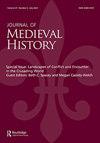塞诺内斯的富人和马萨尔的西比拉的奇特故事:塞诺内斯教会中的伪神圣、托钵者和世界末日
IF 0.3
2区 历史学
0 MEDIEVAL & RENAISSANCE STUDIES
引用次数: 1
摘要
摘要本文探讨了一位13世纪的伪圣人,名叫西比拉(Sibylla of Marsal)的故事,正如当代僧侣和编年史家里彻(Richer of Senones)在其《赛诺尼斯传》(Gesta Senoniensis Ecclesiae)第4卷中所讲述的那样。根据Richer的说法,Sibylla通过使用各种道具假装神圣,包括她用来吓唬村民的恶魔服装,以圣洁的女人的身份在当地声名鹊起。通过分析《盖世塔》第四卷的组织结构,本研究探讨了里彻刻画西比拉的背景和动机,并首次将西比拉置于里彻的启示录世界观中。西比拉的故事也为里彻提供了一个诋毁托钵令的机会。最后,Sibylla在《盖世塔》中的章节揭示了Richer对辨别精神的新兴方法的不信任。本文章由计算机程序翻译,如有差异,请以英文原文为准。
Richer of Senones and the peculiar story of Sibylla of Marsal: pseudo-sanctity, mendicants and the end of the world in the Gesta Senoniensis Ecclesiae
ABSTRACT This article examines the story of a thirteenth-century pseudo-saint named Sibylla of Marsal, as told by contemporary monk and chronicler Richer of Senones in Book 4 of his Gesta Senoniensis Ecclesiae. According to Richer, Sibylla achieved local fame as a holy woman by feigning sanctity using various props, including a demon costume that she wore to frighten villagers. By analysing the organisation of Book 4 of the Gesta, this study explores the context and motivations for Richer’s portrayal of Sibylla and first situates Sibylla within Richer’s apocalyptic worldview. Sibylla’s story also offered Richer an opportunity to denigrate the mendicant orders. Finally, Sibylla’s chapter in the Gesta reveals Richer’s distrust of emerging methods for discerning spirits.
求助全文
通过发布文献求助,成功后即可免费获取论文全文。
去求助
来源期刊

JOURNAL OF MEDIEVAL HISTORY
MEDIEVAL & RENAISSANCE STUDIES-
CiteScore
0.60
自引率
0.00%
发文量
29
期刊介绍:
The Journal of Medieval History aims at meeting the need for a major international publication devoted to all aspects of the history of Europe in the Middle Ages. Each issue comprises around four or five articles on European history, including Britain and Ireland, between the fall of Rome and the Renaissance. The Journal also includes review articles, historiographical essays and state of research studies.
 求助内容:
求助内容: 应助结果提醒方式:
应助结果提醒方式:


